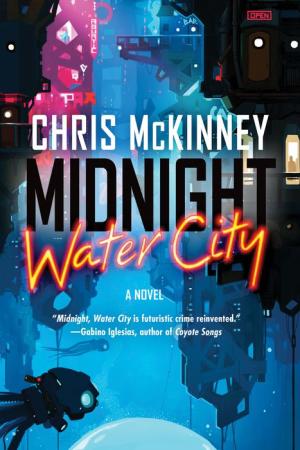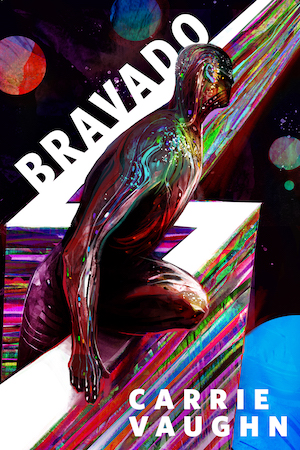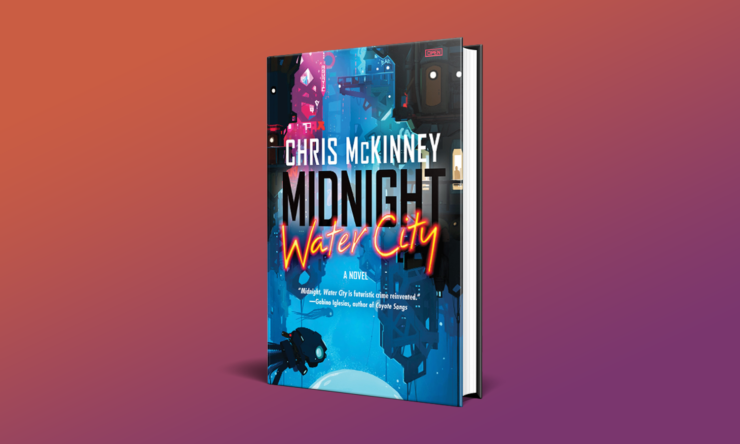There’s long been an overlap between crime fiction and science fiction. And much as the two genres can themselves contain multitudes, so too can those works that situate themselves in their overlap. The corporate espionage of Nicola Griffith’s Ammonite is worlds apart from Isaac Asimov’s R. Daneel Olivaw novels, and the climate fiction noir of Paolo Bacigalupi’s The Water Knife takes a very different tone than the surreal dystopia at the heart of Ricardo Piglia’s The Artificial City.
It’s not hard to see why these two genres have converged so neatly, though. Many writers use crime fiction to reveal hidden elements of society or expose the abuses of those in power—both concepts that play a not insubstantial role in plenty of science fiction as well. And that sense of powerful people concealing crucial secrets from the general public is very much on display in Chris McKinney’s Midnight, Water City—a novel which makes the most of its slow-burning narrative of detection.
The novel’s first two paragraphs establish a few elements that are crucial to the novel’s setting. The year is 2142. Just after the turn of the century, Earth was threatened by an asteroid, which scientist Akira Kimura detected. The weapon that she used to destroy it, Ascalon, left a permanent mark on the sky. Our narrator—who, in the grand tradition of the Continental Op, is never referred to by his name—considers Kimura his “oldest and perhaps dearest friend.” He once handled her personal security; as the novel begins, he’s been summoned to her home for protection.
There’s something else worth mentioning about the narrator—he has the ability to visualize, for lack of a better word, acts of violence. “The wafts start coming at me,” he observes upon entering Kimura’s home. “Death is red, murder green.”
Buy the Book


Midnight Water City
It’s not giving away much to say that the narrator finds Kimura murdered, nor is it a spoiler to say that solving this mystery will lead him into many secrets the nominal savior of humanity had tried to keep buried. In this, McKinney’s novel is archetypal gumshoe fiction; the same could be said of the narrator’s wry observations about “The Money,” which punctuate the book. One example: “The funny thing about The Money is that most of them are very paranoid. Always weary of meeting people. Always wondering what someone wants from them.”
But this is also a novel where a massive underwater city is one of the primary settings and where body modification (including mechanical tails) and extended lifespans are a quotidian part of society. And, apparently, Train’s “Drops of Jupiter” has become a standard, which will likely qualify its setting as full-on dystopian for some readers.
The narrator’s search into Kimura’s past points to at least one massive secret the scientist concealed from the world. It also involves the narrator pondering his own immersion in her world—and the gulf between his working-class ethos and the realms of wealth and privilege he passes through, but is never permitted to settle in. Along the way, several of Kimura’s other associates are murdered; the narrator ends up seeing plenty of both red and green over the course of the book.
About halfway through the novel, I grew concerned about just how its blend of genres would work out. There are long stretches where the narrator’s hunt for answers could be transposed to the present or recent past with only a few details altered. And while there’s nothing inherently wrong in that, there’s also something a little off about setting a mystery in the future without making full use of that fact. Without giving away too much, it’s safe to say that McKinney finds a solution to this conundrum that makes this book work as both a mystery and a work of science fiction.
It’s also a novel about a complicated person becoming aware of the terrible things they’ve done—and the terrible things they’ve been less consciously complicit in. That, too, gives this novel a charge, and makes the narrator less of an archetypal figure and more someone trying to do their best impression of one. Despite its futuristic and timeless elements, that’s one detail that also makes this novel feel very contemporary.
Midnight, Water City is available from Soho Crime.
 Tobias Carroll is the managing editor of Vol.1 Brooklyn. He is the author of the short story collection Transitory (Civil Coping Mechanisms) and the novel Reel (Rare Bird Books).
Tobias Carroll is the managing editor of Vol.1 Brooklyn. He is the author of the short story collection Transitory (Civil Coping Mechanisms) and the novel Reel (Rare Bird Books).










